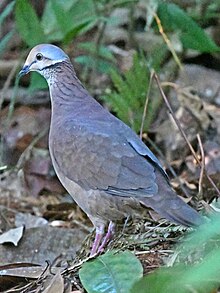
The grey-fronted dove is a large New World tropical dove. It is found on Trinidad and in every mainland South American country except Chile.

The grey-rumped swift or gray-rumped swift is a species of bird in subfamily Apodinae of the swift family Apodidae. It is found in Honduras, Nicaragua, Costa Rica, and Panama; in every mainland South American country except Chile, French Guiana, Suriname, and Uruguay; in Trinidad and Tobago; and on Grenada.

The golden-olive woodpecker is a species of bird in the subfamily Picinae of the woodpecker family Picidae. It is found from Mexico south and east through Panama, in every mainland South American country except Chile, Paraguay, and Uruguay, and Trinidad and Tobago.

The fork-tailed palm swift or Neotropical palm swift is a species of bird in subfamily Apodinae of the swift family Apodidae. It is found across most of northern South America and on Trinidad and Tobago.

The cocoa woodcreeper is a species of bird in the subfamily Dendrocolaptinae of the ovenbird family Furnariidae. It is found in Colombia, Costa Rica, Guatemala, Honduras, Nicaragua, Panama, Trinidad and Tobago, and Venezuela.

The white-tailed goldenthroat is a species of hummingbird in the subfamily Polytminae, the mangoes. It is found in Argentina, Bolivia, Brazil, Colombia, French Guiana, Guyana, Paraguay, Peru, Suriname, Trinidad and Tobago, and Venezuela.

The black-fronted wood quail is a bird species in the family Odontophoridae, the New World quail. It is found in Colombia and Venezuela.

The maroon-chested ground dove is a species of bird in the family Columbidae. It is found in Bolivia, Colombia, Costa Rica, Ecuador, El Salvador, Guatemala, Honduras, Mexico, Panama, Peru, and Venezuela.

The Chiriqui quail-dove or rufous-breasted quail-dove is a species of bird in the family Columbidae. It is found in Costa Rica and Panama.

The buff-fronted quail-dove, or Costa Rican quail-dove, is a species of bird in the family Columbidae. It is found in Costa Rica and Panama.

The white-throated quail-dove is a species of bird in the family Columbidae. It is found in Argentina, Bolivia, Colombia, Ecuador, and Peru.

The russet-crowned quail-dove is a species of bird in the family Columbidae. It is found in Panama and far northwestern Colombia.

The purplish-backed quail-dove is a species of bird in the family Columbidae. It is found in Costa Rica and Panama.

The sapphire quail-dove is a species of bird in the family Columbidae. It is found in Brazil, Colombia, Ecuador, and Peru.

The olive-backed quail-dove is a species of bird in the family Columbidae. It is found in Colombia, Costa Rica, Ecuador, Nicaragua, and Panama.

The violaceous quail-dove is a species of bird in the family Columbidae. It is found in Argentina, Bolivia, Brazil, Colombia, Costa Rica, Guyana, Nicaragua, Panama, Paraguay, Peru, Suriname, and Venezuela.

The grey-chested dove is a species of bird in the family Columbidae. It is found in Belize, Colombia, Costa Rica, Guatemala, Honduras, Mexico, Nicaragua, and Panama.

The Trinidad euphonia is a species of bird in the family Fringillidae. It is common in northern Colombia and northern Venezuela and uncommon to rare on the Caribbean island of Trinidad. Like all euphonias, it is small, stocky, and short-tailed; unlike some, it is sexually dimorphic. The male is glossy blue-black on the head, back, throat, and upper breast, with a bright yellow forehead and crown, and bright yellow underparts. The female is olive-green above and yellow-olive below, with a grayer patch running down the center of her breast and abdomen, and bright yellow undertail coverts. Its calls are high-pitched, plaintive whistles: the two most common are a single-pitched, double-noted "pee pee" or "tee dee", or a rising, double-noted "puwee", "cooleee" or "duu dee". Its song is a short, jumbled mix of musical and nonmusical notes.

The mountain wren is a species of bird in the family Troglodytidae. It is found in the Andes of northwestern Argentina, Bolivia, Colombia, Ecuador, Peru, and western Venezuela.

The purple quail-dove is a species of bird in the family Columbidae. It is found in Colombia and Ecuador.























